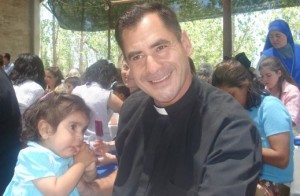 While in Argentina, I saw what spiritual motherhood and fatherhood looks like while spending time with the priests and nuns of the Religious Family of the Incarnate Word.
While in Argentina, I saw what spiritual motherhood and fatherhood looks like while spending time with the priests and nuns of the Religious Family of the Incarnate Word.
I was impressed by the strength, loving discipline, and leadership of the priests. To me, they exemplified masculinity and fatherhood. I was also struck by the joy, helpfulness, and affection of the nuns. To me, they exemplified femininity and motherhood.
This was most evident when the priests and nuns were with the children, young men, or young women. Seeing them interact, you might have thought that they were biological fathers and mothers because you wondered how they could love these children so much.
Spiritual motherhood and fatherhood isn’t just a quaint phrase; it’s a reality. Many of us aren’t used to seeing this kind of love between our religious and our children because of the fears caused by the scandals. But I was blessed to have seen what true, innocent spiritual fatherhood and motherhood looks like.
Seeing this also had another effect on me: it gave me a vision of what kind of mother I want to be and what kind of man I want as the father of my children.
From time to time we hear about the complimentarily of the married and celibate vocations; again, this is not just another quaint phrase. Both the married and celibate vocations are called to self-gift and to fruitfulness, and we can witness to each other and support each other in self-giving and in fruitful love.
Know any priests or nuns who are examples of spiritual motherhood or fatherhood? Take a moment to thank them and encourage them in living out their vocation.

So true! Its not too often I see priests and nuns working side by side (maybe I should be more active in the Church) but when I do see them working together, it is definitely a wonderful testimony of the complementarity of vocations! Thanks for pointing this out, very inspiring.
I met the Institute of the Incarnate Word during a trip to Argentina, as well. I was impressed by the way the live the Gospel. They are also very faithful to the teachings of the Church and to the Pope. Their houses of formation are filled with joyful young people who have willingly left everything to follow Chirst.
You can meet the priests and sisters at St. James’, in Mt Rainier, MD.
Thank you for this great article.
¡El sacerdote que está en la foto es mi hermano: el Padre Vicente, misionero que ha estado en Sudáfrica, tierras de primera evangelización. ¡Me alegro mucho ver su carita feliz, su rostro alegre, viajando por el mundo a través de Internet! Verdaderamente él es feliz trabajando por Cristo, asistiendo a niños, jóvenes y adultos, sanos o enfermos o discapacitados, como le ha tocado estos últimos años. ¡Muchas gracias por mostrar lo que hace este Instituto en el mundo!
I was impressed by the strength, loving discipline, and leadership of the priests. To me, they exemplified masculinity and fatherhood. I was also struck by the joy, helpfulness, and affection of the nuns. To me, they exemplified femininity and motherhood.
I think this is an unhelpful comparison. This is too often and wrongly invoked in explanations of reserving the priesthood to males — that women religious compliment the male priesthood. Nuns are not the feminine counterpart to priests. Priests’ feminine counterpart are the lay faithful, who are the Church; the Bride of Christ.
Men can be vowed religious too (monks,friars and professed brothers). Non-ordained men in religious orders are the counterpart to female religious. To suggest otherwise degrades the meaning of religious life.
Ah, Kurt, you technocrats, you take all the fun out of imagery and symbolism. What if images and symbols weren’t the air-tight, technically precise things you demand them to be. What if Laura was painting for us an impressionistic painting that described her experience of family and complimentarity in the work of the missions? You live in a kind of a binary world it seems but some of us still have access to analog. There is a place for precise theological definition, but there is also a time to simply appreciate the picture someone has painted with a brush rather than pixels or 0s and 1s.
Thank you for the clarifications, Kurt.
My title actually refers to the complimentarity of married life and consecrated life; not the complimentarity of priests and nuns. Perhaps I could have made that more clear. I wanted to say that married people and consecrated people both live lives of self-gift and fruitful love. They are witnesses to each other, and therefore compliment each other.
Thank you, Laura. That is a helpful clarification and I think adds meaning to your post.
As for Msgr. Pope, appreciate your comment that Laura was creating “an impressionistic painting”, but you know, Father, I’ve never understood Modern Art. 🙂
Yeah I’m not a fan of modern Art either although I don’t consider impressionism modern art. Nevertheless, Laura handled your comment well and I’m glad to see y’all have worked it out. :p